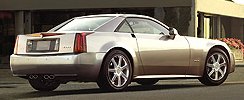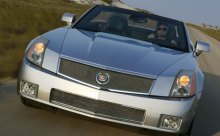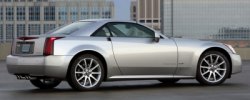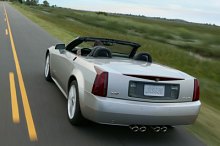|
Cadillac XLR
Debut: 2003
Maker: General Motors
Predecessor: no |
|
 Old
people might remember how proud they owned a Cadillac. However, since
the
60s, the American luxurious marque fell behind European competitors and
became a second division player. Ancient technology, cheap engineering
and poor quality characterized the Cadillac cars from the 70s to the
80s.
In the 90s, the modernized Seville STS scored back a few points, but
then
again it was not good enough to rival its German and Japanese
competitors,
simply because GM did not spend enough money to its jewel-of-the-crown
division. Old
people might remember how proud they owned a Cadillac. However, since
the
60s, the American luxurious marque fell behind European competitors and
became a second division player. Ancient technology, cheap engineering
and poor quality characterized the Cadillac cars from the 70s to the
80s.
In the 90s, the modernized Seville STS scored back a few points, but
then
again it was not good enough to rival its German and Japanese
competitors,
simply because GM did not spend enough money to its jewel-of-the-crown
division.
Since the
launch
of CTS sedan,
we have hope again. The CTS proved that GM is now willing to pursue
engineering
excellence like European companies, even in the price of extra cost and
time. Perhaps they finally understand that this is the only way to
revive
the reputation of Cadillac.
The
CTS is not
completely
perfect. Its interior is the result of cost control - a small mistake,
but could cost its success. Therefore, when Cadillac developed their
range-topping
XLR luxurious roadster, they decided not to repeat this mistake. They
can
save money in somewhere else, but not where the customers can see.
So, what is
XLR?
you can
see it as an American version Mercedes SL500. In terms of size,
accommodation,
power and speed, it follows the format set by the Mercedes benchmark.
It
is rear-drive, powered by a 320hp 4.6-litre Northstar V8, accelerates
from
0-60mph in around 6 seconds and tops 155mph under computer
intervention.
Also like the SL, it has a retractable metal roof which converts it
from
roadster to coupe by pressing a button. Yes, the roof is actually
produced
by the same supplier to the Mercedes. The similarity even spreads to
the
name - XLR versus SL. By the way, Mercedes has an even faster car
called
SLR, are you confused?
Predictably,
Cadillac's uphill
battle is not easy. Because its image was ruined for 3 decades, it can
neither ask for as much money as the SL nor sell as many cars as its
rival.
Mercedes is selling 20,000 SLs a year. Cadillac won't sell more than
8,000
XLRs annually. How can the XLR not making a loss then?
The answer is
to
share platform
with Chevrolet Corvette. What? pardon? do you mean the Vette? yes,
Cadillac
XLR uses a chassis derived from the Corvette - halfway between the
current
C5 and the next generation C6 which is currently under development.
Therefore
it is also produced in the Corvette factory in Kentucky. Like the
Corvette's,
the chassis of XLR is a highly-rigid construction consisting of folded
steel backbone, hydroformed side rails, tubular steel bulkheads,
aluminum
windscreen structure, magnesium steering mount and aluminum/balsawood
composite
floor. This structure is strong yet relatively lightweight, part of the
reason why XLR can undercut SL500 by 110kg. Compare with Corvette, XLR
is slightly shorter, narrower and taller, although luxurious packaging
and retractable roof make it 200kg heavier.
 Under
the chassis lies double-wishbone suspensions at each corner, with
aluminum
control arms. Trademark composite leaf spring for the rear ones prove
that
the suspensions came almost untouched from Corvette. Also like the
recent
update of Corvette (since the 50 Anniversary version), the suspensions
employ magnetic adaptive dampers. Let me have a short explanation here
- GM calls it as Magnetic Ride Control. The Delphi-developed shock
absorbers
use a special magnetorheological fluid instead of the usual oil as
damping
media. Under the application of magnetic field, the viscosity of the
fluid
will change, hence the damping rate. As a result, damping rate can be
instantly
and continuously varied by computer signal. Under
the chassis lies double-wishbone suspensions at each corner, with
aluminum
control arms. Trademark composite leaf spring for the rear ones prove
that
the suspensions came almost untouched from Corvette. Also like the
recent
update of Corvette (since the 50 Anniversary version), the suspensions
employ magnetic adaptive dampers. Let me have a short explanation here
- GM calls it as Magnetic Ride Control. The Delphi-developed shock
absorbers
use a special magnetorheological fluid instead of the usual oil as
damping
media. Under the application of magnetic field, the viscosity of the
fluid
will change, hence the damping rate. As a result, damping rate can be
instantly
and continuously varied by computer signal.
The
heart of XLR
is an uprated
Northstar V8, but now it is amounted longitudinally for the first time
to drive the rear wheels. While displacement remains at 4.6 litres, it
gets continuous VVT at both intake and exhaust camshafts. The result is
an increase of 20hp and 15lbft from the Seville or Deville STS, now
320hp
and 310 lbft. You may ask why not using Corvette’s LS1 small-block V8,
as it is cheaper, lighter yet more powerful. The answer is simple: the
push-rod V8 does not rev as smooth and sound as refined as the 32-valve
Northstar, which is crucial to luxurious car buyers.
The engine
drives
a Tiptronic-style
5-speed automatic transmission shared with CTS and the last generation
BMW 5-series. As in the Vette, it is mounted at the rear axle to
achieve
a wonderful weight distribution of 49% front and 51% rear.
The exterior
styling of XLR
is quite striking. Its angular, stealth-fighter-style body was first
revealed
in the Evoq concept car and just smoothened a little to become the
production
XLR. Many people may prefer the sleeker styling of Mercedes SL and
Jaguar
XK, but the Cadillac really has its own character and is likely to
attract
equal amount of admirers. Surprisingly - or predictably? - the body is
made of glass-fiber-reinforced plastic like the Corvette, but Cadillac
has paid extra attention to quality control so that it is miles ahead
of
the Vette and looks not much different from a steel body except the
smell
of resin. Panels are tightly fitted, assembly gaps are narrow and
consistent,
unlike conventional plastic body cars.
The interior
is
also the
best among current Cadillacs. The generous use of wood and real alloy
delivers
real quality feel while the fit and finish is good. The
multi-adjustable
driving position is excellent, with pretty good visibility. Leather
seats
are comfortable and supportive. Cabin space is never a problem for an
American
car. In contrast, the boot with roof folded offers just half the space
of Mercedes SL, simply because its retractable roof design is simpler
and
cheaper.
When
you drive
the XLR, it
never feels like a Corvette. It is more matured, more refined, with far
better noise insulation and you are surrounded by a high-quality
environment.
So, GM is successful to hide its Corvette underpinnings from the user
interface.
The
Northstar V8
has been
GM’s pride for years for its power, willingness and refinement.
Although
Mercedes’ 5-litre V8 is more torquey from low to mid-range and
therefore
gives the SL an edge in overtaking, the Northstar is freer at the top
end
and delivers a sporty snarl at above 5000rpm. GM’s own 5-speed
automatic
is responsive and seamless to operate, almost matching Mercedes’ box.
The steering
isn’t the most
magnificent one. Magnasteer electrical assistance devoid it of road
feel
and leaves you only ice-cool accuracy and linearity. The chassis is
much
better though, its perfect weight distribution leads to good balance in
corners. Neutral steering can therefore be maintained up to cornering
limit.
The Magnetic Ride Control works well to contain body roll and pitch
while
bump absorption is not sacrificed.
However,
the
Mercedes’ active
body control is ultimately more effective to resist body roll in
cornering
and delivers a higher cornering limit. Moreover, the XLR wears narrower
tires and uses smaller diameter brakes, thus its handling ability is no
where near the class-leading SL. That means, it doesn’t grip the road
as
hard, it runs into understeer at lower cornering speed and it doesn’t
kill
speed as quickly.
That means XLR
is
a nice
car, but not good enough to challenge the near-perfect Mercedes SL.
However,
we have to praise the effort GM spent into the project and its clever
execution,
especially knowing it is derived from the Corvette. |
| The
above report was last updated on 25 Jun
2003. All Rights Reserved. |
XLR-V
|
 At
US$100,000, XLR-V is the most expensive ever Cadillac. Does it have the
qualities to challenge our favourite Mercedes SL55 AMG ? At
US$100,000, XLR-V is the most expensive ever Cadillac. Does it have the
qualities to challenge our favourite Mercedes SL55 AMG ?
As you may have guessed from its name, it is powered by the same
supercharged 4.4-litre Northstar V8 as the recent STS-V. 32 valves and
continuous variable valve timing at all four camshafts mate with an
intercooled Eaton Roots type supercharger located deep into the
V-valley. It boosts a maximum 0.8 bar into the combustion chambers,
resulting in 443 horsepower at 6400 rpm and 414 lbft of torque at 3600
rpm. But wait, why are these figures lower than the STS-V’s 469 hp and
439 lbft ? well, the engine bay of the roadster is tighter than the
sedan, restricting its intake and exhaust manifolds hence breathing
smoothness. This is not a good news, especially when SL55 AMG possesses
500 horsepower and 516 lbft.
The deficit in engine output is not too obvious in 0-60 mph (both cars
do that in around 4.6-4.7 seconds), but by 100 mph the difference is
already a noticeable 1 second (10.3 vs 11.3 sec). The gap will be
widened further until both cars hit their speed regulators set at 155
mph. Fast it may be, XLR-V is not in the same league as SL55 AMG.
Apart from engine, the “V” conversion also includes upgraded gearbox,
suspensions, steering and brakes. How good are they? We shall see one
by one…
 The
rear-mounted transaxle gearbox has been upgraded from 5-speed automatic
to the new GM 6L80 6-speed automatic with manual function. It occurs to
be a good news to Maserati, which has been searching for a suitable
automatic transaxle to replace its unrefined manual-based DuoSelect /
Cambio Corsa, but in fact the GM gearbox is rather slow reacting in
manual mode. Moreover, the manual gearchange is operated via the
traditional shifter rather than paddles or buttons. This is both
outdated and cheap for a roadster at this performance level and this
exclusivity. The
rear-mounted transaxle gearbox has been upgraded from 5-speed automatic
to the new GM 6L80 6-speed automatic with manual function. It occurs to
be a good news to Maserati, which has been searching for a suitable
automatic transaxle to replace its unrefined manual-based DuoSelect /
Cambio Corsa, but in fact the GM gearbox is rather slow reacting in
manual mode. Moreover, the manual gearchange is operated via the
traditional shifter rather than paddles or buttons. This is both
outdated and cheap for a roadster at this performance level and this
exclusivity.
In the suspension side, XLR-V has its Magnetic Ride Control
reprogrammed. When you switch the gearbox to manual mode, the damping
is automatically set to sport mode which firms up the ride. Accompany
with thicker anti-roll bars, body control is excellent. The
well-balanced (50:50) chassis feels agile, but cornering grip is
average, as it employs rather narrow rubbers (235/45 front and 255/40
rear). Most European grand tourers should beat the Cadillac in corners.
 In the
braking department, XLR-V employs larger discs (340 mm front, 330 mm
rear) from the Corvette Z51 package, but again, they are modest for a
1740 kg car. The narrow tires also have a negative effect on braking
distance, as they provide less adhesion to slow down the car. Besides,
road testers found the brake pedal feels spongy, actually worse than
the regular XLR. In the
braking department, XLR-V employs larger discs (340 mm front, 330 mm
rear) from the Corvette Z51 package, but again, they are modest for a
1740 kg car. The narrow tires also have a negative effect on braking
distance, as they provide less adhesion to slow down the car. Besides,
road testers found the brake pedal feels spongy, actually worse than
the regular XLR.
The steering of XLR-V has gained some weight, but unfortunately not
feel. Some people would say Mercedes SL and BMW 6-series are also lack
of steering feel, but in fact their hydraulic servos are still better
than XLR’s Magnasteer electrical assistance.
Inside, the cabin of XLR-V is lifted by full leather upholstery, which
covers the dashboard, console and doors with high-grade stitched
leather. That said, it still lacks the expensive feel of Mercedes.
Refinement is another weakness of XLR-V. The car’s separate frame
chassis and composite body is not the best construction for NVH
suppression. On poorer surfaces there are some body structure shakes
that would not happen in the monocoque SL55 AMG. Cruising on highway,
the noise level is rather high.
Back to our question: is the XLR-V good enough to challenge SL55 AMG ?
well, do you still need an answer ? |
| The
above report was last updated on 26 Apr
2006. All Rights Reserved. |
|
|